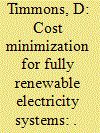|
|
|
Sort Order |
|
|
|
Items / Page
|
|
|
|
|
|
|
| Srl | Item |
| 1 |
ID:
192706


|
|
|
|
|
| Summary/Abstract |
Energy storage reduces total operational costs and greenhouse gas emissions on the grid, while enhancing resilience and renewables integration. This makes energy storage a cornerstone in decarbonization planning. However, project developers building new storage systems may be motivated by energy arbitrage and other revenue streams rather than reducing emissions. Using outputs from ReEDS, which optimizes total system cost, this paper investigates the impacts of marginal storage deployment based on competing environmental, financial and grid system operator interests until 2050. Due to economic motivations, storage developers in some Western states may wait and peak new storage installations around 2030, which maximizes profits and reduces emissions. Conversely, new storage projects in Eastern states are more financially attractive today, but will likely increase short-term GHG emissions unless more renewable electricity is added to the grid, requiring policy-based intervention to achieve further long-term GHG emission reductions. The Inflation Reduction Act may reconcile these competing incentives, but more policies are needed to increase storage deployment while maximizing the emission reduction effect of adding storage to the grid. Midwestern and Southeastern states where storage projects could increase emissions will benefit from tax credits under the IRA. Additional credits to accelerate renewables deployment would reduce long-term emissions from storage and realize decarbonization targets faster.
|
|
|
|
|
|
|
|
|
|
|
|
|
|
|
|
| 2 |
ID:
111087


|
|
|
|
|
| Publication |
2012.
|
| Summary/Abstract |
This paper addresses the dual questions: What is the appropriate storage size and its related properties for matching very large photovoltaic plants to the grid; and what are the available technologies for achieving this end. For this purpose a "Usefulness Index" is defined, which, for any grid flexibility, leads to a PV-storage combination that allows high grid-penetration without storage being wastefully large. The paper then examines the sensitivity of this "appropriate storage size" to variations in our assumptions. The specific case of the Israeli electricity grid is employed for numerical discussion, but the formalism should be useful for wider application. In particular, the "appropriate storage size" deduced in this manner is argued to be a valuable point of departure for optimizations of a more sophisticated nature. Regarding available storage technologies, none is found to have all of the required properties for massive PV-grid penetration, but hybrid combinations should be capable of achieving this end.
|
|
|
|
|
|
|
|
|
|
|
|
|
|
|
|
| 3 |
ID:
192780


|
|
|
|
|
| Summary/Abstract |
Distributed rooftop photovoltaics (PV) is one of the pillars of the energy transition yet their widespread integration strains grids, leading to over-voltage, reverse power flow, and infrastructure strain. Furthermore, increased PV self-consumption reduces imported electricity, posing challenges for cost recovery by Transmission System Operators (TSOs) and Distribution System Operators (DSOs), whose grid costs were traditionally tied to volumetric tariffs. To investigate whether alternative tariffs could mitigate PV impacts at the distribution level without hampering PV development, we assess five electricity tariffs that could help the DSOs to recover the costs of maintaining the distribution grid. We also analyze their effects on private storage investment and their implications for urban, semi-urban, and rural low-voltage networks. We found that tariffs with a capacity-based component promote further adoption of PV and storage. At the same time, they allow the DSOs to recover the grid cost without incurring relevant economic differences for the customer. Our study found that alternative tariffs like dynamic and capacity-based tariffs promote the adoption of storage and PV systems. While no single tariff alone can fully mitigate PV impacts at the distribution level, our results point towards the need of managing PV export through solutions like PV curtailment.
|
|
|
|
|
|
|
|
|
|
|
|
|
|
|
|
| 4 |
ID:
137587


|
|
|
|
|
| Summary/Abstract |
The plunge in oil prices that began in mid-2014 has been relentless. It has pushed a clutch of oil-exporting nations into deficit spending, hobbled Russia’s ambitions, and altered the calculus behind Iran’s nuclear program. It has also given an opportune boost to the U.S. economy and other petroleum-consuming countries. No other force on earth packs such latent capacity to move events. Apart from one, that is: batteries.
|
|
|
|
|
|
|
|
|
|
|
|
|
|
|
|
| 5 |
ID:
115156


|
|
|
|
|
| Publication |
2012.
|
| Summary/Abstract |
We investigate the economic viability of coupling a wind farm with compressed air energy storage (CAES) to participate in the day-ahead electricity market at a time when renewable portfolio standards are not binding and wind competes freely in the marketplace. In our model, the CAES is used to reduce the risk of committing uncertain quantities of wind energy and to shift dispatch of wind generation to high price periods. Other sources of revenue (capacity markets, ancillary services, price arbitrage) are not included in the analysis. We present a model to calculate profit maximizing day-ahead dispatch schedules based on wind forecasts. Annual profits are determined with dispatch schedules and actual wind generation values.
We find that annual income for the modeled wind-CAES system would not cover annualized capital costs using market prices from the years 2006 to 2009. We also estimate market prices with a carbon price of $20 and $50 per tonne CO2 and find that revenue would still not cover the capital costs. The implied cost per tonne of avoided CO2 to make a wind-CAES profitable from trading on the day-ahead market is roughly $100, with large variability due to electric power prices.
|
|
|
|
|
|
|
|
|
|
|
|
|
|
|
|
| 6 |
ID:
150895


|
|
|
|
|
| Summary/Abstract |
Fossil fuels face resource depletion, supply security, and climate change problems; renewable energy (RE) may offer the best prospects for their long-term replacement. However, RE sources differ in many important ways from fossil fuels, particularly in that they are energy flows rather than stocks. The most important RE sources, wind and solar energy, are also intermittent, necessitating major energy storage as these sources increase their share of total energy supply. We show that estimates for the technical potential of RE vary by two orders of magnitude, and argue that values at the lower end of the range must be seriously considered, both because their energy return on energy invested falls, and environmental costs rise, with cumulative output. Finally, most future RE output will be electric, necessitating radical reconfiguration of existing grids to function with intermittent RE.
|
|
|
|
|
|
|
|
|
|
|
|
|
|
|
|
| 7 |
ID:
162293


|
|
|
|
|
| Summary/Abstract |
The technical and financial influences that shape customer investment in behind-the-meter PV and battery systems, provide the means to forecast and quantify customer energy transitions. By utilising techno-economic scenario analysis, this research assists policymakers to understand the impacts of their decisions on future energy market relationships between the customer and utilities. Two case studies are presented, firstly to evaluate the influence of annual increases in usage charges, and secondly the level of feed-in tariff compensation on customer PV and battery investment over a 15-year forecast period located in Perth, Australia. The findings indicate that even without annual increases in usage charges, the falling installation costs of PV and battery technologies will make customer PV-battery systems financially viable within the 15-year forecast period. Additionally, the removal of the feed-in tariff leads to greater reductions in eventual grid consumption. By the end of the forecast period, customer PV-battery systems with the highest financial performance are able to reduce grid consumption above 90% resulting in significant energy resources being transferred out of the energy market. This necessitates the market integration of customer energy resources and provides an opportunity to leverage a combination of customer and utility energy resources for the renewable energy transition.
|
|
|
|
|
|
|
|
|
|
|
|
|
|
|
|
| 8 |
ID:
150358


|
|
|
|
|
| Summary/Abstract |
The inevitable depletion of fossil resources and increasing atmospheric greenhouse gas concentrations demonstrate the need for renewable energy conversion technologies for a sustainable economy. Intermittencies and variability in availability of renewable energy sources are the challenges for uninterrupted energy supply, which can be overcome by large scale energy storage facilities. Pumped hydroelectric energy storage is an efficient but a very low energy density energy storage method that dominates the current energy storage market with ~96% share. We first present a recently developed potential solution for large scale efficient and dense energy storage: closed loop carbon storage cycles and a specific example dimethyl ether storage cycle. We then discuss the relevant US energy storage regulations, policy initiatives, their status, and potential modifications that will contribute to the invention and implementation of novel energy storage systems.
|
|
|
|
|
|
|
|
|
|
|
|
|
|
|
|
| 9 |
ID:
168642


|
|
|
|
|
| Summary/Abstract |
Climate change is the world's most prominent environmental problem, and fossil-fuel combustion is its primary cause. To set carbon reduction goals, policy makers require information on feasibility and cost of renewable energy systems. In this study, we describe an economic approach to modeling a national electricity system based entirely on renewable sources, using the island-nation of Mauritius as a case study.
|
|
|
|
|
|
|
|
|
|
|
|
|
|
|
|
| 10 |
ID:
112312


|
|
|
|
|
| Publication |
2012.
|
| Summary/Abstract |
Both renewable and nuclear energy can provide significant contributions to decarbonizing the electric sector. However, a grid employing large amounts of wind and solar energy requires the balance of the system to be highly flexible to respond to the increased variability of the net load. This makes deployment of conventional nuclear power challenging both due to the technical challenges of plant cycling and economic limits of reduced capacity factor. In the United States nuclear power plants generally provide constant, base load power and are most economic when operated at constant power levels. Operating nuclear power plants in load-following modes decreases the plants' annual energy output and increases the levelized cost of energy, decreasing economic competitiveness.
One possible solution is to couple thermal energy storage to nuclear power plants. This would enable the reactor to remain at nearly constant output, while cycling the electrical generator in response to the variability of the net load. This paper conceptually explores combinations of wind, solar, and nuclear that can provide a large fraction of a system's electricity, assuming the use of thermal energy storage that would allow nuclear power to provide load following and cycling duty while operating at a constant reactor power output.
|
|
|
|
|
|
|
|
|
|
|
|
|
|
|
|
| 11 |
ID:
168664


|
|
|
|
|
| Summary/Abstract |
Energy storage technologies are receiving increasing attention in the UK and around the world as a means of increasing penetration of inflexible low-carbon electricity generation and optimising investment in energy infrastructure required to meet international decarbonisation goals. Research into the social acceptability of energy infrastructure has compellingly illustrated the importance of societal perceptions in the successful deployment of new infrastructure. However to date, no study has empirically examined public perceptions across the broad range of storage technologies available. We address this gap by presenting qualitative findings from four deliberative workshops held with members of the British public. We show that citizens underestimate the challenge of growing volumes of inflexible low-carbon electricity generation, and respond to storage technologies through reference to commonly perceived risks and benefits. When participants discussed how storage might be funded and managed, additional evaluative criteria emerged centred around equity, vulnerability, independence and convenience. Our findings suggest that perceptions of storage technologies tend to be ambivalent, and that acceptance is likely to be contingent on whether storage technologies can be designed, regulated and governed in ways which reduce technical concerns over safety, environmental impacts and reliability, while meeting societal desires for equity and the protection of vulnerable groups.
|
|
|
|
|
|
|
|
|
|
|
|
|
|
|
|
| 12 |
ID:
126498


|
|
|
|
|
| Publication |
2013.
|
| Summary/Abstract |
A number of recent techno-economic studies have shown that energy storage could offer significant benefits to a low-carbon UK energy system as it faces increased challenges in matching supply and demand. However, the majority of this work has not investigated the real-world issues affecting the widespread deployment of storage. This paper is designed to address this gap by drawing on the systems innovation and socio-technical transitions literature to identify some of the most important contextual factors which are likely to influence storage deployment. Specifically it uses a coevolutionary framework to examine how changes in ecosystems, user practices, business strategies, institutions and technologies are creating a new selection environment and potentially opening up the energy system to new variations of storage for both electricity and heat. The analysis shows how these different dimensions of the energy regime can coevolve in mutually reinforcing ways to create alternative pathways for the energy system which in turn have different flexibility requirements and imply different roles for storage technologies. Using this framework three pathways are developed - user led, decentralised and centralised - which illustrate potential long-term trajectories for energy storage technologies in a low-carbon energy system.
|
|
|
|
|
|
|
|
|
|
|
|
|
|
|
|
| 13 |
ID:
132618


|
|
|
|
|
| Publication |
2014.
|
| Summary/Abstract |
The reuse of Li-ion EV batteries for energy storage systems (ESS) in stationary settings is a promising technology to support improved management of demand and supply of electricity. In this paper, MatLAB simulation of a residential energy profile and regulated cost structure is used to analyze the feasibility of and cost savings from repurposing an EV battery unit for peak-shifting. in situ residential energy storage can contribute to the implementation of a smart grid by supporting the reduction of demand during typical peak use periods. Use of an ESS increases household energy use but potentially improves economic effectiveness and reduces greenhouse gas emissions. The research supports the use of financial incentives for Li-ion battery reuse in ESS, including lower energy rates and reduced auxiliary fees.
|
|
|
|
|
|
|
|
|
|
|
|
|
|
|
|
| 14 |
ID:
166375


|
|
|
|
|
| Summary/Abstract |
Over the last decade, supply-side constraints have resulted in widespread electricity shortage in Pakistan. At its peak, this amounted to over a 7 GW supply-demand gap and caused the electricity grid to be offline for vast swathes of population for many hours daily. Despite major supply-side investments acute shortages persist and a large percentage of relatively affluent households, estimated in millions, have countered this by investing in self-generation and battery storage technologies (usually lead-acid batteries because of their low cost). This paper summarizes the impact of this backup technology on the broader energy system in terms of efficiency losses for households and contribution to low-voltage grid congestion. Research findings suggest that the low efficiency of these backup systems has caused annual losses of around 3–4 TWh for the electric grid in Pakistan as well as overloading of transformers and frequent supply-demand imbalances. However, the mass adoption of these backup systems has also created an entire ecosystem which can enable massive demand side management and provide the framework for a future smart grid in Pakistan. Besides evaluating the opportunities, possible policy measures the government should undertake to enable this transition are also discussed.
|
|
|
|
|
|
|
|
|
|
|
|
|
|
|
|
| 15 |
ID:
103413


|
|
|
|
|
| Publication |
2011.
|
| Summary/Abstract |
Faster market integration of new energy technologies can be achieved by use of proper support mechanisms that will create favourable market conditions for such technologies. The best examples of support mechanisms presented in the last two decades have been the various schemes for the promotion of renewable energy sources (RES). In the EU, the most successful supporting schemes are feed-in tariffs which have significantly increased utilisation of renewable energy sources in Germany, Spain, Portugal, Denmark and many other EU countries. Despite the successful feed-in tariffs for RES promotion, in many cases RES penetration is limited by power system requirements linked to the intermittency of RES sources and technical capabilities of grids. These problems can be solved by implementation of energy storage technologies like reversible or pumped hydro, hydrogen, batteries or any other technology that can be used for balancing or dump load. In this paper, feed-in tariffs for various energy storage technologies are discussed along with a proposal for their application in more appropriate regions. After successful application on islands and outermost regions, energy storage tariffs should be also applied in mainland power systems. Increased use of energy storage could optimise existing assets on the market.
|
|
|
|
|
|
|
|
|
|
|
|
|
|
|
|
| 16 |
ID:
126488


|
|
|
|
|
| Publication |
2013.
|
| Summary/Abstract |
Battery energy storage is a flexible and responsive form of storing electrical energy from Renewable generation. The need for energy storage mainly stems from the intermittent nature of solar and wind energy sources. System integrators are investigating ways to design plants that can provide more stable output power without compromising the financial performance that is vital for investors. Network operators on the other side set stringent requirements for the commissioning of new generation, including preferential terms for energy providers with a well-defined generation profile. The aim of this work is to highlight the market and technology drivers that impact the feasibility of battery energy storage in a Utility-scale solar PV project. A simulation tool combines a battery cycling and lifetime model with a solar generation profile and electricity market prices. The business cases of the present market conditions and a projected future scenario are analyzed.
|
|
|
|
|
|
|
|
|
|
|
|
|
|
|
|
| 17 |
ID:
149999


|
|
|
|
|
| Summary/Abstract |
Emerging grid resources such as energy storage and demand response have the potential to provide numerous environmental and societal benefits, but are primarily sited and operated to provide grid-specific services without optimizing these co-benefits. We present a four-metric framework to identify priority regions to deploy and dispatch these technologies to displace marginal grid air emissions with high environmental and health impacts. To the standard metrics of total mass and rate of air pollutant emissions we add location and time, to prioritize emission displacement near densely populated areas with poor air quality, especially at times when air pollutant concentrations exceed regulatory standards. We illustrate our framework with a case study using storage, demand response, and other technologies to displace peaker power plants, the highest-rate marginal emitters on the California grid. We combine spatial-temporal data on plant electricity generation, air quality standard exceedance days, and population characteristics available from environmental justice screening tool CalEnviroScreen 2.0 to determine where emissions reductions may have the greatest marginal benefit. This screening approach can inform grid siting decisions, such as storage in lieu of peaker plants in high impact regions, or dispatch protocol, such as triggering demand response instead of peaker plants on poor air quality days.
|
|
|
|
|
|
|
|
|
|
|
|
|
|
|
|
| 18 |
ID:
166481


|
|
|
|
|
| Summary/Abstract |
Electricity market models are widely employed to study the role, impacts and economic viability of new technologies. Sources of arbitrage, such as storage and transmission, are increasingly seen as essential for integrating higher shares of variable renewables. Understanding their operation and business case requires models which accurately represent time-series of wholesale electricity prices.
|
|
|
|
|
|
|
|
|
|
|
|
|
|
|
|
| 19 |
ID:
103490


|
|
|
|
|
| Publication |
2011.
|
| Summary/Abstract |
We examine the changes to the electric power system required to incorporate high penetration of variable wind and solar electricity generation in a transmission constrained grid. Simulations were performed in the Texas, US (ERCOT) grid where different mixes of wind, solar photovoltaic and concentrating solar power meet up to 80% of the electric demand. The primary constraints on incorporation of these sources at large scale are the limited time coincidence of the resource with normal electricity demand, combined with the limited flexibility of thermal generators to reduce output. An additional constraint in the ERCOT system is the current inability to exchange power with neighboring grids.
By themselves, these constraints would result in unusable renewable generation and increased costs. But a highly flexible system - with must-run baseload generators virtually eliminated - allows for penetrations of up to about 50% variable generation with curtailment rates of less than 10%. For penetration levels up to 80% of the system's electricity demand, keeping curtailments to less than 10% requires a combination of load shifting and storage equal to about one day of average demand.
|
|
|
|
|
|
|
|
|
|
|
|
|
|
|
|
| 20 |
ID:
169715


|
|
|
|
|
| Summary/Abstract |
We assess the ability of distributed solar to defer distribution capacity projects in a typical low load growth utility in the Northeast USA, PECO. We find that targeted placement can increase the deferral value of solar up to fourfold, but that deferrable projects are rare. In our baseline scenario, we find a 5% solar energy penetration with Net Energy Metering rolled out from 2020 to 2030 would increase rates by 0.8% over a 20-year horizon and generate just $1 MM in net present deferral value. This estimate assumes untargeted placement of solar, a low effective capacity (i.e. the reduction in peak load relative to solar's nominal capacity), a 1% growth rate, and 1% of PECO's distribution yearly capex budget that is deferrable. A higher effective capacity (e.g. from coupling energy storage with solar) and targeted placement could generate a net $8 MM of value over the same horizon, but the rate increase is mostly unaffected. We recommend the use of targeted solar placement in utility planning processes. Compared to untargeted placement, targeted placement can increase the total deferral value fourfold, but the effect on rates is small for PECO because few capacity deferral opportunities exist.
|
|
|
|
|
|
|
|
|
|
|
|
|
|
|
|
|
|
|
|
|